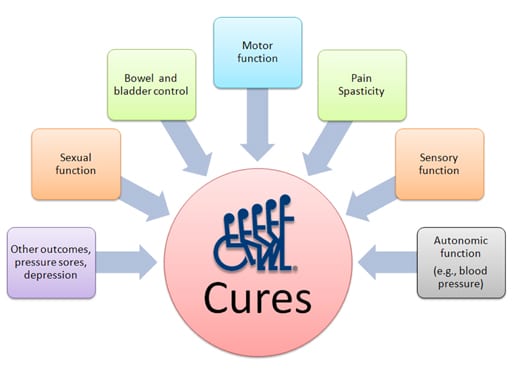SPINAL CORD INJURY CURES
Injury to the central nervous system (CNS) has devastating effects on the structure and function of the brain and spinal cord. Since the early 1980s, immense research progress has been made and has given hope that injuries to the CNS will one day be repairable. Still, there is much that researchers need to learn about the complex processes that occur in the brain and spinal cord after injury, and how those processes can be changed or reversed.
Miami Project investigators carry out a broad scope of research to address the consequences of neurological injuries. Their work is directed at the following areas:
- Understanding what happens after CNS injury
- Protecting the injured brain and spinal cord from further damage
- Replacing dead nervous system cells (neurons and glia)
- Promoting and guiding axon growth
- Reestablishing essential circuitry
- Preventing and treating complications
- Maintaining maximum potential for recovery
- Translating findings from laboratory research to clinical trials
Defining a Cure
Injury to the central nervous system affects many body systems and functions that influence the health and well-being of a person. Often, when one thinks of a cure, the focus is on restoring motor function, or walking.
However, cures for spinal cord injury—as defined in Spinal Cord Injury: Progress, Promise and Priorities by the Institute of Medicine of the National Academies—should alleviate the multiple disabilities that result from spinal cord injury.
“Spinal cord injury research should focus on preventing the loss of function and on restoring lost functions—including sensory, motor, bowel, bladder, autonomic, and sexual functions—with the elimination of complications, particularly pain, spasticity, pressure sores, and depression, with the ultimate goal of fully restoring the activity and function of an individual to his or her pre-injury levels.”
From: Progress, Promise and Priorities
The longstanding mission of The Miami Project is to find better treatments and, ultimately, a cure for the paralysis resulting from spinal cord injury.

Figure adapted and reproduced with permission from “Spinal Cord Injury: Progress, Promise, and Priorities”© 2005 by the National Academy of Sciences, Courtesy of the National Academies Press, Washington, D.C.
W. Dalton Dietrich, Ph.D.
Scientific Director, The Miami Project to Cure Paralysis
